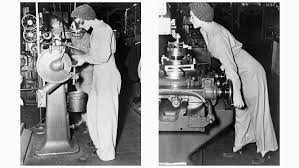WHO REALLY WAS ROSIE THE RIVETER?
The true identity of Rosie the Riveter has been the subject of considerable debate for many years. In fact, since the Rosie the Riveter campaign consisted of various publications and posters, there were a number of Rosie’s identified in history:
- Geraldine Hoff Doyle of Michigan, worked in a Navy machine shop during World War II for a brief period. A photographer took a picture of her during her two week employment at the machine shop. She later saw the picture and identified it as her younger self which fueled the Rosie myth.
- Rose Will Monroe, who worked as a riveter at the Willow Run Bomber Plant near Detroit. Monroe was featured in a promotional film for war bonds which led people to believe that she was the inspiration for Rosie.
- Rosalind P. Walter from Long Island, New York, is considered to be the Rosie from a song by Evans and Loeb. Walter was actually a riveter on Corsair fighter planes.
- However, the most credible claim on Rosie’s myth came from Naomi Parker Fraley, who was photographed working in the machine shop at the Naval Air Station in Alameda, California. In the 1942 photo, she was photographed in work coveralls, black loafers and a polka-dotted bandana to restrain her hair for safety.
For many years, there was conflicting information as to the true identity of Rosie. Dr. James J. Kimble, a professor at Seton Hall, began researching her true identity.
While attending a reunion for female war workers in 2011, Naomi Parker Fraley saw the picture with the caption underneath it acknowledging Gerald Huff Doyle as the female in the picture. Naomi new the information to be wrong and wrote the National Park Services to correct the error. But got nowhere. She also had a clipping of the original picture with her name in the caption below.

Fraley didn’t gain recognition for her contribution to the war effort until 2016 after Dr. Kimble concluded his research. Naomi Parker Fraley passed away in January 2018.Eventually Dr. Kimble stumbled onto the facts that there was another name to add to the list of possible Rosie’s, Naomi Parker Farley. After interviewing her and an exhausted search of historical records, he was able to conclude that Naomi Parker Fraley was most likely the model used to portray the “We Can Do It” poster created by Westinghouse. He believes the picture was the inspiration for the poster.
Become a supporter today of the U.S. Army Museum of Hawaii, by purchasing a souvenir Ha-Go Shirt. All donations support the maintenance and upkeep of the our artifacts and exhibits.
We look forward to seeing you soon!
